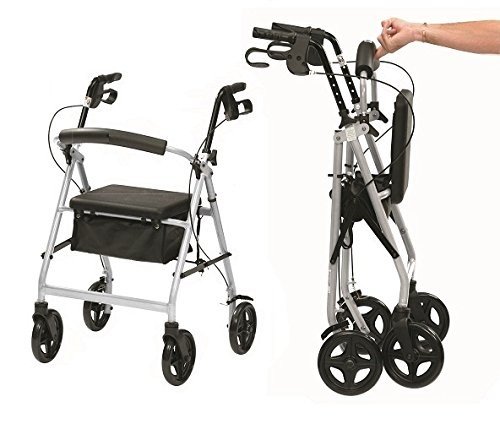medical-walker3969
medical-walker3969
Five Killer Quora Answers On Adjustable Walker
Understanding Adjustable Walkers: A Comprehensive Guide
Adjustable walkers are essential mobility aids developed to provide stability and support to individuals with mobility challenges. They enhance independence, safety, and confidence for people recuperating from surgery, handling chronic conditions, or dealing with age-related mobility problems. This article looks into the features, types, benefits, and typical FAQs connected to adjustable walkers, providing insights for prospective users and caretakers.
What is an Adjustable Walker?
An adjustable walker is a mobility aid that usually includes a lightweight frame with four legs, geared up with handgrips for assistance. It can be gotten used to accommodate different heights, ensuring users obtain a comfortable wrist position while supporting their weight. Adjustable walkers can be found in different designs, each tailored to particular needs.
Secret Features of Adjustable Walkers
- Height Adjustment: Most adjustable walkers have telescoping legs, enabling users to easily customize the height to match their stature.
- Weight Capacity: Different models accommodate differing weight limits, dealing with a broad market.
- Foldability: Many walkers are collapsible, making them simple to shop and transport.
- Wheels vs. No Wheels: Some walkers include wheels on the front legs, while others have a basic design without wheels, promoting stability.
- Additional Accessories: Walkers can typically be geared up with trays, baskets, or cup holders for added benefit.
| Feature | Description |
|---|---|
| Height Adjustment | Telescoping legs for customized height settings |
| Weight Capacity | Differs by design, supporting various body weights |
| Foldability | Collapsible style for easy transportation and storage |
| Wheels | Readily available in both wheeled and non-wheeled alternatives |
| Additional Accessories | Trays, baskets, and cup holders for user benefit |
Kinds Of Adjustable Walkers
- Requirement Walkers: Traditional designs with four legs. Best for those looking for maximum stability.
- Wheeled Walkers (Rollators): Walkers with two or more wheels, enabling easier maneuvering.
- Hemi Walkers: Designed for individuals with the use of one hand, including a single arm assistance for included stability.
- Child Walkers: Specifically created for babies finding out to stroll, promoting safety and assistance throughout early mobility.
Benefits of Using Adjustable Walkers
Increase Independence
- Enhanced Mobility: Adjustable walkers enable users to browse their environments with more ease and confidence, promoting a sense of self-reliance.
- Accessibility: With the right walker, users can keep their lifestyle and participate in activities they take pleasure in without help.
Injury Prevention
- Stability and Support: Walker users can maintain better balance and avoid falls, which are particularly important for seniors and people recovering from surgical treatment.
- Lowered Strain: Proper use of a walker can reduce tension on joints and muscles, decreasing the risk of injury throughout mobility.
Convenience and Customization
- Adjustable Settings: Walkers can be tailored to each user’s height and convenience, offering a more tailored experience.
- Additional Features: Options for devices help in accommodating individual needs, enabling users to bring items while moving.
Costs and Considerations
The price of adjustable walkers varies depending on features, products, and brand name. Here’s an introduction of the average expenses associated with different types:

| Walker Type | Typical Cost |
|---|---|
| Standard Walkers | ₤ 50 – ₤ 100 |
| Wheeled Walkers | ₤ 75 – ₤ 200 |
| Hemi Walkers | ₤ 60 – ₤ 150 |
| Infant Walkers | ₤ 30 – ₤ 70 |
Regularly Asked Questions (FAQs)
1. How do I know which adjustable walker is best for me?
The ideal adjustable walker depends upon your specific needs, physical condition, and environment. It’s important to speak with a health care expert to identify the most appropriate type.
2. Can I change the height of any walker?
Many adjustable walkers feature a height-adjustment system. Nevertheless, not all walkers are adjustable. It’s essential to take a look at item specs before purchasing.
3. Are wheeled walkers safe to use?
Yes, wheeled walkers (or rollators) are safe for users who can browse them appropriately. They often include brakes for added safety when fixed.

4. How do I take care of my adjustable walker?
Regular care involves cleaning up the walker with moderate soap and water, looking for wear on grips and wheels, and ensuring systems run smoothly.
5. Can I take my adjustable walker on public transport?
Yes, many adjustable walkers are foldable and developed for simple transport. However, it’s recommended to examine the specific standards of the transportation service.
6. Do I need support to use an adjustable walker?
Lots of users can operate adjustable walkers independently, especially when correctly fitted to their height. However, those with serious mobility issues may gain from support.
Adjustable walkers are invaluable tools for enhancing mobility, independence, and safety. With a variety of design and styles, individuals can discover a walker customized to their needs. Caregivers and users alike should appreciate the significance of speaking with healthcare professionals to make educated decisions concerning mobility aids. Understanding the features, benefits, and considerations of adjustable walkers empowers people to keep an active way of life, enhancing their quality of life despite mobility difficulties.



